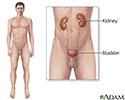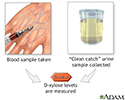D-xylose absorption
Xylose tolerance test; Diarrhea - xylose; Malnutrition - xylose; Sprue - xylose; Celiac - xylose
D-xylose absorption is a laboratory test to determine how well the intestines absorb a simple sugar (D-xylose). The test helps determine if nutrients are being properly absorbed.
How the Test is Performed
The test requires a blood and urine sample. These tests include:
-
Clean catch urine specimen
Clean catch urine specimen
A urine culture is a lab test to check for bacteria or other germs in a urine sample. It can be used to check for a urinary tract infection in adults...
 ImageRead Article Now Book Mark Article
ImageRead Article Now Book Mark Article -
Venipuncture (blood draw)
Venipuncture (blood draw)
Venipuncture is the collection of blood from a vein. It is most often done for laboratory testing.
 ImageRead Article Now Book Mark Article
ImageRead Article Now Book Mark Article
There are several ways to perform this test. A typical procedure is described below, but make sure you follow the specific instructions you are given.
You will be asked to drink 8 ounces (240 ml) of water that contains 25 grams of a sugar called d-xylose. The amount of d-xylose that comes out in your urine over the next 5 hours will be measured. You may have a blood sample collected at 1 and 3 hours after drinking the liquid. The amount of urine you produce over a 5-hour period is also determined. Your health care provider will tell you how to collect all of the urine during a 5-hour period.
How to Prepare for the Test
Do not eat or drink anything (even water) for 8 to 12 hours before the test. Do not exercise before the test. A failure to restrict activity may affect test results.
Your provider may tell you to stop taking certain drugs that can affect test results. Drugs that can affect test results include aspirin, atropine, indomethacin, isocarboxazid, and phenelzine. Never stop taking any medicine without first talking to your doctor.
How the Test will Feel
When the needle is inserted to draw blood, you may feel moderate pain, or only a prick or stinging sensation. Afterward, there may be some throbbing.
Urine is collected as part of normal urination with no discomfort.
Why the Test is Performed
Your provider may order this test if you have:
- Persistent diarrhea
- Signs of malnutrition
- Unexplained weight loss
This test is primarily used to determine if nutrient absorption problems are due to a disease of the intestines.
Normal Results
A normal result depends on how much D-xylose is given. In most cases, the test results are either positive or negative. A positive result means that D-xylose is found in the blood or urine and is therefore being absorbed by the intestines.
Normal value ranges may vary slightly among different laboratories. Some labs use different measurements or test different samples. Talk to your provider about the meaning of your specific test results.
What Abnormal Results Mean
Lower than normal values may be seen in:
-
Celiac disease (sprue)
Celiac disease (sprue)
Celiac disease is a condition caused by damage to the lining of the small intestine. This damage comes from a reaction to eating gluten. This is a ...
 ImageRead Article Now Book Mark Article
ImageRead Article Now Book Mark Article -
Crohn disease
Crohn disease
Crohn disease is a disease where parts of the digestive tract become inflamed. It most often involves the lower end of the small intestine and the be...
 ImageRead Article Now Book Mark Article
ImageRead Article Now Book Mark Article -
Giardia
lamblia infestation
Giardia
Giardia, or giardiasis, is an infection of the small intestine. A tiny parasite called Giardia lamblia causes it.
 ImageRead Article Now Book Mark Article
ImageRead Article Now Book Mark Article -
Hookworm
infestation
Hookworm
Hookworm infection is caused by roundworms. The disease affects the small intestine and lungs.
 ImageRead Article Now Book Mark Article
ImageRead Article Now Book Mark Article -
Lymphatic obstruction
Lymphatic obstruction
Lymphatic obstruction is a blockage of the lymph vessels that drain fluid from tissues throughout the body and allow immune cells to travel where the...
 ImageRead Article Now Book Mark Article
ImageRead Article Now Book Mark Article -
Radiation enteropathy
Radiation enteropathy
Radiation enteritis is damage to the lining of the intestines (bowels) caused by radiation therapy, which is a type of cancer treatment.
 ImageRead Article Now Book Mark Article
ImageRead Article Now Book Mark Article - Small intestinal bacterial overgrowth
-
Viral gastroenteritis
Viral gastroenteritis
Viral gastroenteritis is present when a virus causes an infection of the stomach and intestine. The infection can lead to diarrhea and vomiting. It...
 ImageRead Article Now Book Mark Article
ImageRead Article Now Book Mark Article -
Whipple disease
Whipple disease
Whipple disease is a rare condition that prevents the small intestines from allowing nutrients to pass into the rest of the body. This is called mal...
Read Article Now Book Mark Article
Risks
Risks associated with having blood drawn are slight, but may include:
- Excessive bleeding
- Fainting or feeling lightheaded
- Hematoma (blood accumulating under the skin)
- Infection (a slight risk any time the skin is broken)
Considerations
Multiple tests may be necessary to determine the reason for malabsorption .
Malabsorption
Malabsorption involves problems with the body's ability to take in nutrients from food.

References
Hogenauer C, Hammer HF. Maldigestion and malabsorption. In: Feldman M, Friedman LS, Brandt LJ, eds. Sleisenger and Fordtran's Gastrointestinal and Liver Disease. 10th ed. Philadelphia, PA: Elsevier Saunders; 2016:chap 104.
Semrad CE. Approach to the patient with diarrhea and malabsorption. In: Goldman L, Schafer AI, eds. Goldman's Cecil Medicine . 25th ed. Philadelphia, PA: Elsevier Saunders; 2016:chap 140.
-
Male urinary system - illustration
The urinary system is made up of the kidneys, ureters, urethra and bladder.
Male urinary system
illustration
-
D-xylose level tests - illustration
The D-xylose tolerance tests measure the intestines' ability to absorb D-xylose, a simple sugar, as an indicator of whether nutrients are being properly absorbed.
D-xylose level tests
illustration
-
Male urinary system - illustration
The urinary system is made up of the kidneys, ureters, urethra and bladder.
Male urinary system
illustration
-
D-xylose level tests - illustration
The D-xylose tolerance tests measure the intestines' ability to absorb D-xylose, a simple sugar, as an indicator of whether nutrients are being properly absorbed.
D-xylose level tests
illustration
Review Date: 1/28/2016
Reviewed By: Subodh K. Lal, MD, gastroenterologist at Gastrointestinal Specialists of Georgia, Austell, GA. Review provided by VeriMed Healthcare Network. Also reviewed by David Zieve, MD, MHA, Isla Ogilvie, PhD, and the A.D.A.M. Editorial team.


